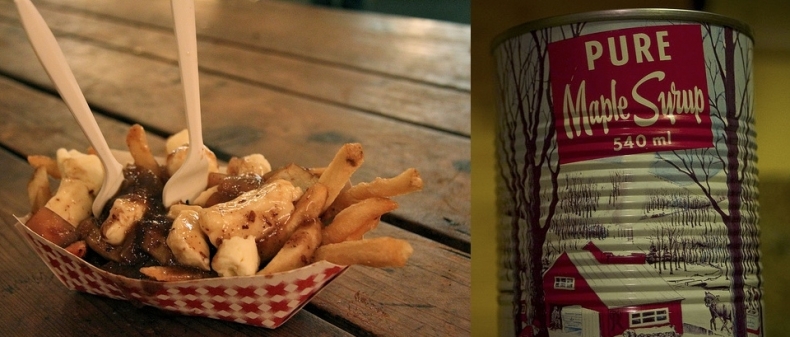
Images via flickr / pkingDesign and jballuch
There’s no doubt that Toronto prides itself on the culinary scene we’ve fostered over the past few years. Last year alone, 150 new restaurants opened in Hogtown, a fair amount of them to crowds and critical acclaim. But while Torontonians went crazy for tacos and ramen, I had to ask myself how a city that has become such a big food destination seemed to lack a distinct cuisine of our own– one that is recognizably Canadian.
If you ask people what they think ‘Canadian’ cuisine is, most will probably cite poutine, bacon, and maple syrup as Canadian foods. But a cohesive and definable style of dishes? Well, that’s a little harder for us to agree on.
Sure, food trends like tacos and ramen may reflect our city and country’s multiculturalism, but they don’t necessarily showcase the ingredients (fish, game, raw vegetables, to name a few) or the traditional food preparation techniques (smoking, curing, etc) that have been native to this land for centuries. In trying to pinpoint what Canadian cuisine is, or if it even exists, I posed the question to chefs at some of Toronto’s most popular restaurants.
For Executive Chef Chris Kalisperas of Brassaii, local ingredients are the key to defining any region-specific cuisine, Canada’s included. “I believe every part of Canada has its own distinctive cuisine,” says Kalisperas when I meet him. “Whatever’s available to us at the time of year and what local foragers can find for restaurants, or we can go and forage ourselves and make from that, that’s what we can consider Canadian cuisine.”
Kalisperas’ winter dinner menu includes one dish that is particularly exemplary of this thinking, a mash salad using wild rose apples from the Okanagan Valley in British Columbia. “When we cut it, it’s all pink inside,” he boasts.
Over the past few decades, environmental responsibility and local pride have lead more and more chefs around the world to use local ingredients whenever possible. Gone are the days when the exotic was prized. In today’s culinary scene, local is king.
One restaurant that has drawn particular media attention to the use of local ingredients and traditional food preparation techniques is Copenhagen’s Noma, and while these ideas are not new, the gospel of the Manifesto for the Nordic Cuisine has become known around the world.
Of the manifesto’s ten commandments, 2, 3, and 4 seem most in line with Canadian values as we might apply them to defining Canadian cuisine. They are:
2. To reflect the changing of the seasons in the meals we make.
3. To base our cooking on ingredients and produce whose characteristics are particularly excellent in our climates, landscapes and waters.
4. To combine the demand for good taste with modern knowledge of health and well-being.
In a globalizing world where food shortages co-exist with food wastage and obesity, where prices for food are rising ever upwards, these three rules seem as if they should be staples of any cuisine. And indeed, through the eyes of Toronto’s chefs, they’re already staples of Canadian cooking.
“The use of local ingredients is … a common sense approach to cooking with the best most regionally appropriate ingredients that any proper cook would consider normal,” writes Chef Michael Caballo of Toronto’s Edulis restaurant in an e-mail. To him, popular trends in cooking such as smoking and fermenting “have been used by native populations all around the world for centuries. Canada included.”
Caballo is right of course, but it’s also not hard to see why people don’t automatically think of Canadian cuisine when smoking, fermenting, and raw winter vegetables pop up on the New York Times‘ list of food trends for 2013. We just haven’t laid claim to them in the same in-your-face way that other cuisines–Scandinavian for example–have.
For Brassaii’s Kalisperas this is because we’re still in the process of discovering all the ingredients that Canada has to offer. “Once everything’s been foraged and we’ve discovered different and new ingredients, we can actually say this belongs to us.”
Chef Darren Glew of The Drake Hotel also thinks Canadian cuisine has a way to go before it can define itself as something independent from other cuisines. For Glew, Canadian cuisine today is about chefs taking things they’ve tasted and loved, and using their training to bring it to the next level.
“We’re a culture of many cultures, right?” he asks. “So it’s not so much about a particular dish, but the way we combine them.” But even when it comes trends like tacos and ramen that can, as Glew says, be associated with certain ethnic cultures, we find a way to make them our own.
Glew’s Lobster Nachos. Image via The Drake
When it comes to his own menu at The Drake, Glew cites the Lobster Nachos, a dish that contains local ingredients, as a perfect example of a Canadian dish. It shows French influence with a Mornay sauce, features east-coast lobster, and comes with Latin-American style tortillas, handmade just six blocks away from the Drake’s Queen West location.
Glew’s dish is certainly of combination of ingredients, foods, and methods that speaks to former Prime Minister Joe Clark’s infamous definition of Canadian cuisine as a “smörgÃ¥sbord” of other cuisines. Yet it doesn’t necessarily make the definition of Canadian cuisine any clearer.
Perhaps our cuisine will always be defined by the multiculturalism of the Canadian people. Or perhaps Canadian cuisine remains indefinable because it is still in its infancy, still developing, still finding itself. “But that’s the beauty of it,” says Glew. “I think that’s our strength.”
____
Eva Voinigescu is an intern at Toronto Standard. Follow her on Twitter @EvaVoinigescu.
For more, follow us on Twitter at @torontostandard and subscribe to our Newsletter.














